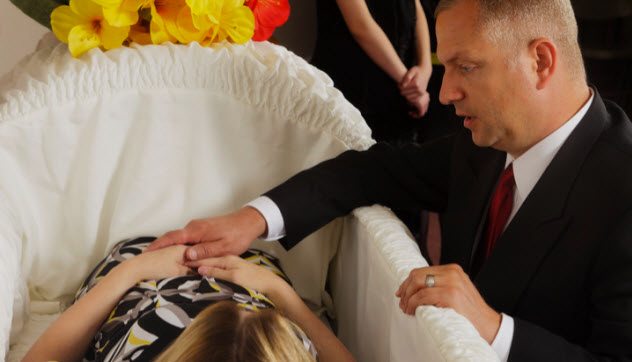From ancient cultures like the Egyptians to historical figures charged with necromancy as part of evil rituals, the story of humankind is rife with loving the dead. Our seemingly innate fear of the dead is mysterious enough without trying to comprehend the dark obsession we have with death. Especially for those who take it too far. Here are 10 facts about the macabre practice of necrophilia.
10 It’s Hardly A Mental Disorder
According to The American DSM-5 (Diagnostic and Statistical Manual of Mental Disorders, Fifth Edition), necrophilia doesn’t get its own spot as a tried-and-true mental illness. It belongs to a broader category called paraphilias, which is sexual attraction or practices with people or objects other than genital stimulation between consenting adults. The only reason that necrophilia is on the list is because the dead cannot consent. Aside from that, necrophilia is not all that odd, psychologically speaking. While most of us recoil in horror at the idea due to the innate human tendency to be afraid of death, a dead person was once a living person while objects were not. Surprisingly, nailing down exactly what makes necrophilia a mental disorder has proven rather challenging. According to Martin Kafka in the paper “The DSM Diagnostic Criteria for Paraphilia Not Otherwise Specified,” there really isn’t much new data on necrophilia besides a 1989 study by Rosman and Resnick. In the aforementioned paper by Kafka, he writes: Necrophilia could be considered as a fetish variant as the sexualized object of desire is “nonliving” but, in my opinion, there are insufficient data to empirically support this change to include Necrophilia as a subtype of Fetishism. Necrophilia can be accompanied by “sadistic acts” and sexually motivated murder, certainly not behaviors associated with Fetishism as it has been currently defined.[1] This means that the only real reason that necrophilia “may be” a sexual fetish is because a dead person cannot consent. Which is kind of a bizarre hitch to have to fall back on.
9 It Is A Paraphilia
Paraphilias become mental disorders when they significantly impact someone’s life in a meaningful way, much like alcohol isn’t alcoholism until it becomes a real pain for someone. Paraphilias can either involve objects (e.g., shoes, household appliances, foods, clothing) or acts (e.g., exposing one’s self to an unwilling party, being whipped, being bound). The list of paraphilias spans the entirety of human history. But paraphilias become mental disorders only when they “are recurrent, intense, occur over a period of at least six months, and cause significant distress or interfere with important areas of functioning.” This is important because not everyone who enjoys a spanking or leather is “mentally ill.” On the other side of that coin, however, the main factor in necrophilia being a mental disorder is the fact that it’s illegal. When most of us think of necrophilia, we think of Ted Bundy. But in that 1989 research on necrophilia, a full 57 percent of the people studied worked in a place that had access to corpses. This raises the big question: Are these people truly necrophilic, or do they just do it because they can as a result of occupational access?[2] Which do you think comes first—motive or opportunity?
8 Psychopathia Sexualis
Although necrophilia was mentioned for the first time by name in 1850 by Belgian psychiatrist Joseph Guislain, Psychopathia Sexualis (1886) by Richard von Krafft-Ebing gives us our first detailed description of necrophilia and seeks to answer the question on mental soundness. In this work, Krafft-Ebing said, “[An] abnormal and decidedly perverse sensuality is required to overcome the natural repugnance which man has for a corpse, and permit a feeling of pleasure to be experienced with a cadaver.” He also went on to say: Unfortunately, in the majority of the cases reported, the mental condition was not examined; so that the question whether necrophilia is compatible with mental soundness must remain open. But anyone having knowledge of the horrible aberrations of the sexual instinct would not venture, without further consideration, to answer the question in the negative.[3] So, if you’re a necrophile, you may be a freak, but that doesn’t automatically make you crazy.
7 There Are Four Types
While necrophilia is a gross and disturbing fetish no matter how you slice it, there are actually different layers to it—like an onion that one begins to peel back to expose its filthy core. According to the literature of Rosman and Resnick, there are four different types of necrophiles: homicidal necrophiles, so-called “regular” necrophiles, fantasizers, and pseudo-necrophiles (or pseudo-necrophilic killers). All of them are described with some fairly telling data. For example, 68 percent of necrophilia comes from people who express a desire to be with a partner who cannot reject them in any way. Even more disturbing, 42 percent of necrophiles had actually committed homicide to obtain a body with which to act out their desires.[4] This paints a picture in the opposite direction—that many necrophiles go to the extreme of killing another person to act out their urges. However, we can be somewhat sympathetic to the 21 percent of necrophiles studied who desired a “union with a lost love.” Strangely, only 15 percent are individuals who simply have a sexual attraction to dead people, a number you would expect to be higher among a group of people defined by the fact that they do the deed with the dead.
6 It’s A Guy Thing
Necrophilia is a particularly male thing. In the study mentioned earlier, 95 percent of the necrophiles were men. In addition, 100 percent of the cases of necrophilic homicide were perpetrated by men. Women were only present to any noticeable degree in “regular necrophilia” at 15 percent of the participants sampled. This may suggest that opportunity comes before motive. Rather than people getting into a field which provides them with an opportunity to carry out their necrophilic fantasies, people who end up as “regular necrophiles” may tend to be in those careers by chance. This provides them with an opportunity to have sex with the dead. When that opportunity presents itself, they take it. Occasionally, there is emphasis on the extremely rare case of a woman necrophile. One such example occurred in America in 2013 when a woman who was apparently “obsessed with necrophilia” convinced two male partners to aid her in killing two other men. She wanted to have sex with the two live men on top of the two male corpses that had been freshly killed. And she succeeded with both the murders and the sex act. In 2014, 20-year-old Alissa Massaro (some sources spell her name “Alisa”) agreed to a reduced sentence in exchange for testifying against the coconspirators who helped to fulfill her necrophilic fantasies. She was released in 2018 after serving less than four years of her sentence.[5]
5 Necrophilic Homicide
Necrophilic homicide is what terrifies us the most—the thought of sexual deviants who act out their fantasies on unwilling participants. The victims are killed so that the perpetrators can satisfy their violent urges. On the topic of necrophilia, even Sigmund Freud said, “Enough of this horror!” Necrophilic homicides are the cases which are extremely sensationalized, even though they are rare. These disturbing cases include serial killers and depraved madmen who murder the victim, dispose of the body, and then retrieve the body to either relive the killing experience or just enjoy sex with it again and again.[6]
4 Regular Necrophilia
For regular necrophiles, sexual attraction toward or intercourse with corpses is a part of their everyday lives. They are the mortuary assistants and gravediggers like Peter Sutcliffe, The Yorkshire Ripper. He was an English serial killer who was employed to dig graves as a youth. Sutcliffe eventually graduated to serial murder, killing prostitutes to obtain their corpses and have sex with them. Although the act of committing homicide before having sex with the corpse is considered “homicidal necrophilia,” any fantasies that Sutcliffe had while working as a gravedigger would have fallen under the classification of “regular necrophilia.” In fact, necrophilic fantasies are a part of “regular necrophilia.” For a variety of reasons, these people generally are not satisfied by having sex with live people. Sometimes, they just aren’t attracted to living people. Other times, they’re terrified of rejection.[7]
3 Pseudo-Necrophiles
Pseudo-necrophiles generally have sex with dead bodies in passing—when a rare moment presents itself at just the right time. So they decide to have sex with a corpse that they have on hand. It happens by chance alone. This is strikingly odd as well as a testament to the disturbing flexibility of the human sex drive. Someone who doesn’t normally possess any necrophilic tendencies somehow stumbles upon a dead body in their otherwise normal course of life and it puts them in the mood. One case of pseudo-necrophilia presented in “Sexual Attraction to Corpses: A Psychiatric Review of Necrophilia” goes as follows: A 37-year-old, single, white man went out drinking with his 49-year-old girlfriend. He had been a heavy drinker since his teen years. On the way home, he shot her through the head “by accident.” He said he had felt threatened by a passerby who stopped to bother him. While he was engaged in hiding the body, he became sexually excited. He had anal intercourse with the corpse.[8] Yeah. That’s just bizarre.
2 Necrophilia In History
History is rife with necrophilic descriptions, art, and literature. As can be imagined by their practices of embalming and their religious obsession with the afterlife, the ancient Egyptians had a lot to say about necrophilia. In one of their major myths, three of their gods partake in a necrophilic tale that sheds light on their belief systems. The story goes that Seth and Osiris were enemies. Seth killed Osiris and cut his corpse into pieces. Then Isis goes all Frankenstein with Osiris’s corpse and pieces it back together. But there’s one problem. Isis can’t find Osiris’s penis. So she substitutes another phallic object and attaches it to the corpse. Then she has sex with Osiris’s body, of course. The ancient Greeks and Egyptians were close for quite a while after Alexander the Great. Herodotus, an ancient Greek writer, gives this advice to mourners who want the corpses of their friends and family members to remain safe, secure, and chaste: The wives of men of rank are not given to be embalmed immediately after death, nor indeed are any of the more beautiful and valued women. It is not till they have been dead three or four days that they are carried to the embalmers. This is done to prevent indignities from being offered them.[9] Herodotus knew it was smart to let a fresh corpse rot in the Sun for a couple of days before handing it over to the embalmers in ancient Egypt.
1 Modern Necrophilia
Modern culture is also filled with references to and artful displays of necrophilia. Heavy metal imagery, particularly in the case of death metal bands such as Cannibal Corpse, often make necrophilia a dominant lyrical theme throughout their discography. The first song on Exhumed’s 1998 album Gore Metal is a track called “Necromaniac.” Thirteen years later, the same band, on the album All Guts, No Glory, had a song titled “Necrotized.” The whole subgenre of music is littered with necrophilic themes. Literature, too, has its moments. Edgar Allan Poe hints at necrophilia in the closing of his poem “Annabel Lee” with the words: For the moon never beams, without bringing me dreams Of the beautiful Annabel Lee; And the stars never rise, but I feel the bright eyes Of the beautiful Annabel Lee; And so, all the night-tide, I lie down by the side Of my darling—my darling—my life and my bride, In her sepulchre there by the sea, In her tomb by the sounding sea. Poe left the ending ambiguous. Although it could have been a metaphor, the verses here appear to be hinting at necrophilia. One of the most unusual, true cases of modern necrophilia is the story of Carl Tanzler, who was born in Germany. Tanzler moved to the United States and was a doctor in Key West, Florida. He loved Maria Elena Milagro de Hoyos obsessively and just couldn’t let her go. Tanzler had been treating her for tuberculosis. Unfortunately, Hoyos died from the disease. Unable to stay away from her, Tanzler broke into her tomb, carted her body out of the cemetery on a toy wagon, and took it home. Tanzler used an impressive array of objects, such as wires, to piece the decomposing parts of the corpse together. Chunks of her hair began to fall out due to rotting. But Tanzler managed to carefully make a wig from the hair and keep her looking somewhat normal. By the time he was found out, Hoyos’s body looked more like a mummy than anything else. It was completely pieced together with mostly foreign objects, rags stuffed inside to hold its shape, and wax covering its surface where the skin had decomposed. Apparently, Tanzler created a mummy that he could love and tried to maintain it as best he could.[10] He was caught when locals became suspicious of the fact that he never visited her resting place anymore. Even more bizarre, others spotted him dancing with a “large doll.” He was brought up on charges of wantonly and maliciously destroying a grave and removing a body without authorization. I like the dark stuff, morbid humor and macabre entertainment, particularly things with a philosophical or psychological twist; I own and manage Serial Killer Memes, Murderworks Horror, Beautifully Disturbed, and several other Facebook pages, as well as other social media outlets.
























